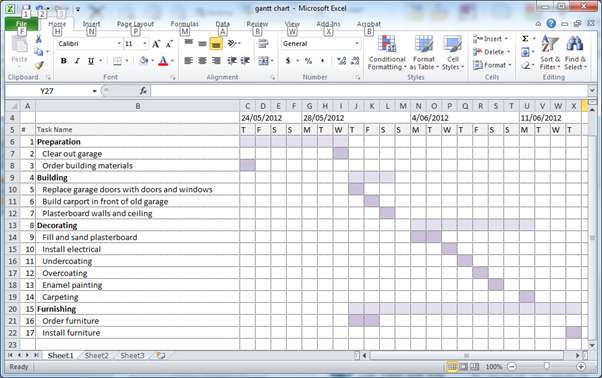In the previous topic, you learned about the importance of following the agreed scope management plans and procedures and the steps involved in identifying and reporting non-compliances and variations.
In this topic, you will learn how to identify required changes to the scope, initiate those changes according to agreed change management procedures, and review the effectiveness of project outcomes to inform future projects.
The review of project outcomes and the effectiveness of the planned scope, plans, processes, and procedures are critical in how the organisation uses continuous improvement to inform future projects, thereby improving project efficiencies and effectiveness over time.
This topic covers the skills and knowledge required for you to:
- Identify scope changes against the scope management plan with assistance
- Contribute to reporting scope changes
- Participate in reviewing the effectiveness of project outcomes.
Required changes to the scope can be identified through regular project reviews and through discussing with and consultation of your project manager and other project stakeholders.
You can assist in the identification of scope changes against the scope management plan by regularly reviewing the project progress against plans and thereby identifying variances to the plan. For example, by reviewing the project schedule and identifying which activities have been started, are in progress, and have been completed, you will be able to identify whether the project is on time, behind or, in front. The same comparison needs to be made in terms of the incurred costs and approved budget, as well as the achieved deliverables and Key Performance Indicators against targets.
Any variances you identify as part of this review will need to be reported, discussed, and actioned.
Once you have identified a variance and the need for project scope changes, you need to complete the following tasks with the assistance of your project manager and other stakeholders:
- Specify the size of the required adjustment
- Follow the agreed change control processes
- Communicate scope changes to relevant stakeholders.
Specify the size of the required adjustment
If the project scope requires an adjustment, e.g. an increase in budget or timeline, then the size of the required adjustment must be identified before a change request to adjust the project scope can be submitted.
Example
- A project may be delayed by three weeks at the point of review. This would require the project to be extended by three weeks. This would require an update of the project scope and other relevant documentation, such as action plans, Gantt charts, etc.
- The market price may have increased by 20%. This would require an increase in the project budget, e.g. from $10,000 to $12,000. This would require an update of the project scope and other relevant documentation, such as the budget plan.
Follow formal change-control processes
The adjustment to the project scope needs to be processed in a standardised and agreed manner. Once the adjustment has been specified, the next step will be to conduct the formal change control process, which entails the necessary change request.
Things that are typically done in the formal change-control process include:
The formal change-control process ensures that:
- The change is documented using the correct form and providing all relevant information to make an informed decision about the change.
- A decision about the approval or rejection of the change request is made based on provided facts and data.
- Impacts of the change request are assessed. Impacts may be on scope, costs, or schedule. For example, a change may require additional resources previously not planned for.
- It is identified which documents need to be updated as a result of the change—for example, scope document, project plan, budget.
- The change is documented for tracked purposes.
Change request

If the result of your review is that for example, the budget needs to be increased, then you will need to lodge a budget change request with your project manager. A small change in the budget may not require a formal change request, but a larger adjustment will need to be formally approved. Check with your project manager for which amounts need formal approval. Use your organisation’s change request form when seeking a change to the project scope (e.g. time, cost, quality).
Project Change Request Template
The following template shows a change request form which can be used to request a change to the project scope formally at any stage of the project. This form allows you to describe the change reasons for the change and the change impact.
Page 1
| Project Name: | |||
| Prepared by: | |||
| Date: | |||
| Changes are being made to the following: | |||
| Project Charter | Project Management Approach | ||
| Scope Statement | Work Breakdown Structure | ||
| Performance Measurement Baselines | Major Milestones and Target Dates | ||
| Key Staff | Risk Management Plan | ||
| Scope Management Plan | Schedule Management Plan | ||
| Cost Management Plan | Quality Management Plan | ||
| Staffing Management Plan | Communications Management Plan | ||
| Risk Response Plan | Procurement Management Plan | ||
| Type of change: | |||
| Scope | Time | Cost | Quality |
| Communications | Resources | Risk | Procurement |
| Areas impacted: | |||
| Scope | Time | Cost | Quality |
| Communications | Resources | Risk | Procurement |
| Changes to Supporting Detail? (explain): | |||
Page 2
| Description of Changes being made: | ||
|---|---|---|
| 1. | ||
| Risk Issues Prompting Changes: Corrective Action: |
||
| 2. | ||
| Risk Issues Prompting Changes: Corrective Action: |
||
| 3. | ||
| Risk Issues Prompting Changes: Corrective Action: |
||
| 4. | ||
| Risk Issues Prompting Changes: Corrective Action: |
||
| 5. | ||
| Risk Issues Prompting Changes: Corrective Action: |
||
| 6. | ||
| Risk Issues Prompting Changes: Corrective Action: |
||
| 7. | ||
| Risk Issues Prompting Changes: Corrective Action: |
||
| 8. | ||
| Risk Issues Prompting Changes: Corrective Action: |
||
| Stakeholders being notified: | ||
| Name/Title | Signature | Date |
| Name/Title | Signature | Date |
Click here to download a copy of the template.
Case Study

Consider the following scenario:
Your client is insisting on the development of a customised financial management database you are developing so they can be delivered on time, and they do have a cost buffer that they can access. You can deliver the project by adding three new C++ programmers. The cost increase with the new staff will be $20,000.
The client has also asked for additional scope – the development of a secure web interface into the system. This is outside of the scope that your development company can do, but you know another company that can subcontract to you to perform the work. Your client is happy with this arrangement. The contractor will do their part of the work for $52,000 and will require a contract/MOU to be drawn up. The developer will need to provide weekly status reports to your team, and your online issues register will need to allow for web interface-based issues to be allocated directly to their team by e-mail to their project manager.
The project schedule will need to be reworked to incorporate the new scope, so the web interface is completed before the staff testing phase of the project.
As the web interface is considered a high-risk development project, you will need to add an additional risk to the risk register. Additionally, an additional audit template will need to be created to closely monitor the quality of the work they will be producing for the project.
When you analyse the above scenario, you will find the change is around scope and HR because the client has requested additional scope, and to meet the deadline, you need to hire additional staff.
This scenario impacts all eight functions of project management. Specifically, they are:
| Scope |
|
| Time |
|
| Cost |
|
| Quality |
|
| Human Resources |
|
| Communications |
|
| Risk Management |
|
| Procurement |
|
This is quite a substantial change to the project, but changes of this scale happen to projects all the time, no matter how well they have previously been planned.
Now that you have been informed of this enormous change, how do you deal with it? A well-run project team will have a change management process in place. This includes a change control procedure and a change request template where the changes are populated and signed off. Once the change request has been signed off, other project documentation will need to be altered, but that will be covered later.
You have been supplied with a sample change request for the mentioned scenario below. This has been included with the change information incorporated in it.
Change Request for the Case Study
Page 1
| Project Name: Financial Management Database Development | |||
| Prepared by: Jeff White | |||
| Date: 23 May 2012 | |||
| Changes are being made to the following: | |||
| Project Charter | Project Management Approach | ||
| X Scope Statement | Work Breakdown Structure | ||
| X Performance Measurement Baselines | Major Milestones and Target Dates | ||
| X Key Staff | Risk Management Plan | ||
| X Scope Management Plan | Schedule Management Plan | ||
| Cost Management Plan | Quality Management Plan | ||
| Staffing Management Plan | Communications Management Plan | ||
| X Risk Response Plan | Procurement Management Plan | ||
| Type of change: | |||
| X Scope | Time | X Cost | Quality |
| Communications | X Resources | Risk | Procurement |
| Areas impacted: | |||
| X Scope | X Time | X Cost | X Quality |
| X Communications | X Resources | X Risk | X Procurement |
| Changes to Supporting Detail? (explain): | |||
Page 2
| Description of Changes being made: | ||
|---|---|---|
| 1. The addition of the web portal to the scope of the project. | ||
| Risk Issues Prompting Changes: | ||
|
||
| Corrective Action: | ||
|
||
| 2. The addition of three new C++ developers to the project team to ensure the project is delivered on time. | ||
| Risk Issues Prompting Changes: | ||
|
||
| Corrective Action: | ||
|
||
| Stakeholders being notified: | ||
| Name/Title | Signature | Date |
| Name/Title | Signature | Date |
Click here to download a copy of the completed Change Request Form.
Check your understanding

Once the changes to the project scope have been approved through the change request procedure, you will need to communicate the changes to all relevant stakeholders.
Explain to them the following:
- The changes made
- Reasons for the change
- Impacts on for each stakeholder, in terms of time, costs, and quality
- Documents that were adjusted
- New processes and procedures put in place (if any)
Reporting may depend on organisational policies and procedures. Refer to your organisation’s policies and reporting procedures.
You can report the scope changes to relevant project stakeholders in different ways. Either verbally in a meeting or written. If you choose the written format, then you may use a scope change report, log, or summary to outline and communicate the changes.
| Scope Change Summary | |
|---|---|
| Project Name: | Financial Management Database Development |
| Prepared by: | Jeff White |
| Date: | 23 May 2012 |
| Description of change: |
|
| Reason for change: |
|
| Impacts of change: |
|
Check your understanding

Reviewing project outcomes
Reviewing the effectiveness of project outcomes involves two types of reviews:
- Review of project progress and outcomes
- Review of the agreed scope and relevant plans, processes, and procedures.
Review of project progress and outcomes
The review of project progress and work outcomes occurs as part of the monitoring and the closure of the project. In both cases, you will need to compare the planned project scope and outcomes against the achieved outcomes. This also includes reviewing achievements against the agreed budget, schedule, and other requirements that have been defined as part of the project scope.
The project progress and outcomes can be measured in terms such as the following:
- Cost - Compare actual project expenses to date against what was initially budgeted for the project. This is done through variance analyses of actual project costs against estimated costs.
- Schedule - Evaluate current project progress against schedule baselines. This is done through variance analyses of when milestones were accomplished against schedule baselines.
- Quality - Evaluate the quality of project deliverables completed against project quality requirements and standards established at the beginning of the project. This is done through validation of scope, e.g. product reviews, walkthroughs, and inspections.
You can use the following methods for measuring project progress against the project plan:
- Units completed - This method is used when project tasks are done repeatedly, assuming that each task is completed with the same amount of time, resources, and effort. Each task is then counted and totalled.
- Incremental milestones - Also known as the ‘steps’ method. This method is used for projects that involve subtasks that need to be completed in an orderly fashion.
- Start/finish - This method is used to determine the percentage of the work completed and the percentage of the work that is still yet to be completed, e.g. 80% complete, 20% to go.
The other ways to establish the project's performance were discussed in Topic 3.2. Other methods for measuring work outcomes and progress may include:
- Conducting iterative reviews against performance management plans
- Reporting iterative progress (e.g. daily, weekly)
- Using Gantt Charts to demonstrate progress against activities.
Gantt charts
A Gantt Chart is a visual representation of the tasks and timeline of a project. It lists all milestones, activities, and tasks in sequential order, and plots the timeline on the right. It uses a different colour for planned tasks, tasks completed, and those that are delayed.
A completed Gantt chart will look something like this:

Review of the agreed scope and relevant plans, processes, and procedures
A review also needs to occur related to whether the agreed scope and relevant plans, processes, and procedures defined during the scoping phase and adjusted throughout the project implementation were complete, correct, achievable, and communicated.
Questions that need to be answered here include:
- Was the project scope defined in sufficient detail?
- Was the project scope delivered?
- Did the project scope need to be changed, and why?
- Was the project scope change conducted according to the agreed change-control process?
- Were the initial project scope and any changes to the scope communicated to relevant stakeholders?
- Was relevant documentation updated after changes were made to the scope?
Methods for reviewing project outcomes and the effectiveness of the project scope and relevant plan, processes, and procedures may be based on the following:
- final project reports
- gap analysis
- lessons learned
- listing and scheduling activities
- reviewing budgets, communications, goals, and quality objectives
- stakeholder satisfaction.
There are many methods for reviewing the effectiveness of project outcomes, but there are methods that are often used in this review.
These are:
Click on the methods to learn more about each.
Preparation of the Lessons Learned document
Lessons Learned are part of the Continuous Improvement Process called PDCA. The PDCA (Plan, Do, Check, Act) process is a well-known formula for creating incremental change in all types of industries. You should use this approach to complete your reviews throughout and at the end of the project life cycle.
The PDCA process is shown in the following figure:
The PDCA cycle is a circular process, which means you should continuously review and make required adjustments until the project is closed. The steps in the PCDA process are defined as follows:
| PDCA Steps | Description |
|---|---|
| Plan | Plan and document the project objectives, requirements, schedules, key performance indicators, plans, processes, and procedures. |
| Do | Implement the project schedule. |
| Check | Frequently check whether the plan is on track and if there are any variations. |
|
Act |
Address any issues identified and document the Lessons Learned for future projects. |
Similar problems, variations, and non-compliances to the ones identified for your project will likely come up again in the future. To assist in the organisational learning process, ensure to document and share the learnings and actions taken with others in the organisation through Lessons Learned. Having a verified solution will prevent similar issues in the future.
Preparing the Lessons Learned document is a standard approach used in businesses to capture the positive and negative experiences of a project and suggest ways to prevent the negative experiences in future projects. Hence, a Lessons Learned document should record:
- What went well
- What did not go well
- What actions were taken to overcome the issues
- How these and similar issues could be prevented in the future.
The Lessons Learned document can only be successful if shared with those that may be able to use it to inform future project planning and to avoid similar project issues.
This may be shared through:
- A flyer
- An email
- An announcement
- A post online (e.g. intranet, social media)
Additionally, the lessons learned need to be communicated to people who are likely to come across it again. If you keep the Lesson to yourself and someone else in the team comes across the same issue, they will be spending unnecessary time trying to work it out when you have the solution right in front of you.
Example of a Lessons Learned template
The following Lessons Learned template outlines the information that should be captured when developing the lessons learned from the current project. You can use this template if your organisation does not provide one. Who should be informed about this Lesson Learned?
(Hint: All stakeholders should benefit from Lessons Learned, for different reasons.)
| Lessons Learned Template | |
|---|---|
| Project Name: | |
| Prepared by: | |
| Date: | |
| Lesson Learned Number: | |
| Lesson Learned Proposed Name: | |
| Project Team Role: | |
| Specific Project Management Process Being Used: | |
| Specific Practice, Tool or Technique Being Used: | |
| What was the action undertaken? | |
| What was the result? | |
| What might have been a more preferred result? | |
| What might have created the more preferred result? | |
| What is the specific Lesson Learned? | |
| How could one identify a similar situation in the future? | |
| What behaviour is recommended for the future? | |
| Where and how can this knowledge be used later in this current project? | |
| Where and how can this knowledge be used in a future project? | |
Click here to download a copy of the Lessons Learned template.
Preparing a postmortem project review
Postmortem reviews are conducted at the closure of the project, just like the Lessons Learned. During this review, the project outcomes are compared against the project plans to identify what was achieved and if there are any outstanding tasks and deliverables and whether the project objectives have been achieved. This is usually conducted in the form of a project meeting with all stakeholders that are present. During this review, the project’s positives and negatives (e.g. delays and budget overruns) are also discussed.
The purpose of this meeting is to finalise the project as well as to learn from problems that were experienced throughout the planning and execution. This can then lead to the documentation of the Lessons Learned discussed earlier.
In summary, both the post-mortem and lessons learned are similar in their purpose of reviewing project outcomes and identifying what can be learned for future projects. The suggestion is to conduct a post-mortem project review, whereby identifying the project outcomes against targets, and then using the Lessons Learned to document and communicate the learnings from the project.
Reading
Click here to read more on the Lessons Learned procedure in detail, as provided by the Project Management Institute.Check your understanding
Read the following statement and decide whether they are TRUE or FALSE:
Read the following case study, then try to answer the questions that follow to test your knowledge and understanding of this topic:
Case Study

As the leading interior design company in the state, the lead architect will be conducting a project outcome review. The team has been thoroughly studying the results of each of their projects to maintain the integrity of the company, as well as continuously improving their standards of work. This time, they will base their review on their most recent project, a 10-story apartment located in the middle of a major community.
The client spared no expense, as they asked for a combination of minimalist and modern designs for each unit. The project manager was able to secure a sizeable portion of the budget for purchasing the most luxurious furniture to truly satisfy the expectations of the client. Despite this, the project cost outcome review was astounded the team. The actual cost of interior design was significantly lower than the estimated cost of $25,000. The cost of the project was totalled to only $21,000, mostly due to the smart usage of materials and deals with suppliers.
Another notable accomplishment is completing the project at a reasonable pace. The client was expecting the project to be finished within 4 months. But with hard work and proper management of the team’s schedule, the project was completed 2 weeks earlier or ahead of schedule. This was based on analysing the project milestones against the schedule baseline. Then the team used the start/finish method to measure the progress of the project. According to data, the project was already 75% complete by the end of the 3rd month.
The client and their potential tenants were extremely impressed with the results. After extensive receiving reviews and completing the final inspection, the team was thrilled to find out that clients are breath taken by the stylish and sleek designs of their new homes. According to the lead architect, the designs were inspired by shapes and shades of colour seen from nature.
1. What is the project cost outcome?
2. What is the project schedule outcome?
3. What is the project quality outcome?
4. What is the project measuring method used by the team?
5. What are some Lessons Learned from this case study?
- Effective Cost Management: Careful selection of materials and negotiating favourable deals with suppliers can significantly reduce costs while maintaining high-quality standards.
- Efficient Scheduling: Proper management and adherence to a detailed schedule can lead to early project completion, exceeding client expectations.
- Client Satisfaction: Meeting and exceeding client expectations through attention to design details and quality can result in high client satisfaction and positive feedback.
- Importance of Design Inspiration: Drawing design inspiration from natural elements can enhance the appeal and uniqueness of the project, contributing to client approval and satisfaction.
